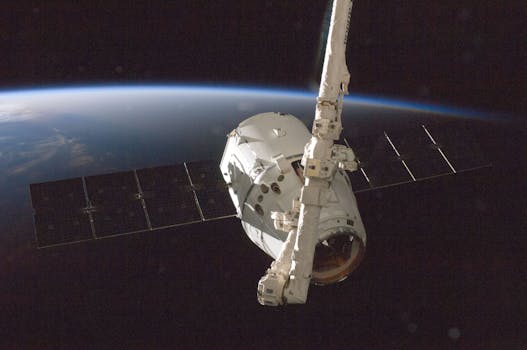
Introduction to LEO Satellites
LEO satellites, or Low Earth Orbit satellites, are a type of satellite that orbits the Earth at an altitude of around 160 to 2,000 kilometers. The Focus Keyword LEO satellites have been gaining popularity in recent years due to their ability to provide faster and more reliable connections than traditional Geostationary (GEO) satellites. With the increasing demand for global connectivity, LEO satellites are playing a crucial role in bridging the digital divide and enabling communication in remote and underserved areas.
How LEO Satellites Work
LEO satellites work by orbiting the Earth at a low altitude, which allows them to provide faster and more reliable connections than traditional GEO satellites. They are typically launched into orbit using a rocket and then released into space, where they begin their orbit around the Earth. LEO satellites use advanced technology, such as phased array antennas and high-gain amplifiers, to provide high-speed connections and reliable communication services. They are also designed to be highly maneuverable, allowing them to quickly adjust their orbit and position to provide optimal coverage and service.
Benefits of LEO Satellites
The benefits of LEO satellites are numerous and significant. One of the primary advantages is their ability to provide faster and more reliable connections than traditional GEO satellites. LEO satellites have lower latency and higher throughput, making them ideal for applications that require real-time communication, such as video conferencing and online gaming. They also offer greater flexibility and scalability, allowing them to be easily integrated into existing networks and infrastructure. Additionally, LEO satellites are more cost-effective than traditional GEO satellites, making them an attractive option for organizations and individuals looking to establish or expand their communication networks.
Applications of LEO Satellites
LEO satellites have a wide range of applications, including satellite broadband, satellite navigation, and earth observation. They are also used for scientific research, such as studying the Earth’s atmosphere and monitoring climate change. LEO satellites are also being used for military and defense applications, such as providing secure communication services and surveillance capabilities. Furthermore, LEO satellites are being used for commercial purposes, such as providing internet services to remote and underserved areas, and enabling communication for emergency response and disaster relief efforts.
Conclusion
In conclusion, LEO satellites are revolutionizing the way we communicate and access information. With their ability to provide faster and more reliable connections, they are playing a crucial role in bridging the digital divide and enabling communication in remote and underserved areas. As the demand for global connectivity continues to grow, LEO satellites will become an increasingly important part of our communication infrastructure. With their numerous benefits and wide range of applications, LEO satellites are an exciting and rapidly evolving field that holds great promise for the future of communication and technology.
Future Developments
As the technology continues to evolve, we can expect to see even more innovative applications of LEO satellites. One of the most exciting developments is the launch of constellations of LEO satellites, which will provide global coverage and enable communication services to be provided to even the most remote and underserved areas. Additionally, advancements in technology will enable LEO satellites to provide even faster and more reliable connections, making them an attractive option for a wide range of applications. With the continued growth and development of LEO satellites, we can expect to see significant improvements in global connectivity and communication capabilities.
Challenges and Limitations
While LEO satellites offer many benefits and advantages, there are also challenges and limitations to their use. One of the primary challenges is the high cost of launching and operating LEO satellites, which can make them prohibitively expensive for some organizations and individuals. Additionally, LEO satellites are subject to interference from other satellites and terrestrial systems, which can impact their performance and reliability. Furthermore, the low altitude of LEO satellites means that they are more susceptible to atmospheric interference and degradation, which can affect their signal quality and availability.
Real-World Examples
There are many real-world examples of LEO satellites being used to provide communication services and enable global connectivity. One example is the Iridium satellite constellation, which provides global coverage and enables communication services to be provided to remote and underserved areas. Another example is the OneWeb satellite constellation, which is being developed to provide high-speed internet services to underserved communities around the world. These examples demonstrate the potential of LEO satellites to transform the way we communicate and access information, and highlight the importance of continued investment and development in this field.
Regulatory Environment
The regulatory environment for LEO satellites is complex and evolving. There are a number of international and national regulations that govern the use of LEO satellites, including the International Telecommunication Union (ITU) regulations and the Federal Communications Commission (FCC) regulations in the United States. These regulations are designed to ensure that LEO satellites are used safely and responsibly, and to prevent interference with other satellites and terrestrial systems. As the use of LEO satellites continues to grow, it is likely that the regulatory environment will become increasingly important, and that new regulations and guidelines will be developed to govern their use.
Conclusion
In conclusion, LEO satellites are a rapidly evolving field that holds great promise for the future of communication and technology. With their ability to provide faster and more reliable connections, they are playing a crucial role in bridging the digital divide and enabling communication in remote and underserved areas. As the demand for global connectivity continues to grow, LEO satellites will become an increasingly important part of our communication infrastructure. With their numerous benefits and wide range of applications, LEO satellites are an exciting and rapidly evolving field that holds great promise for the future of communication and technology.




